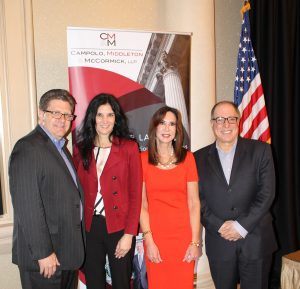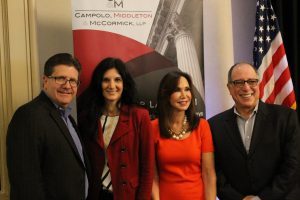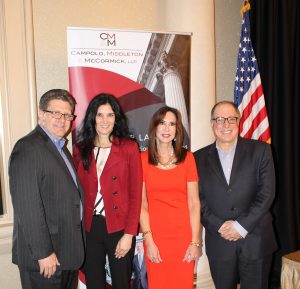
How do you transition from distributing paper products stored in your mother-in-law’s garage using an old van to owning a 150,000-square foot facility and becoming one of the leading distributors of general merchandise and food throughout the world? According to David Emrani, co-founder and president of Pride Products based in Ronkonkoma: “a lot of hard work.” An engineering background, comfort conducting business across the globe, and supportive colleagues who are also family don’t hurt, either.
Joe Campolo, Managing Partner of Campolo, Middleton & McCormick, recently sat down with CMM clients and friends David and Roya Emrani, the husband and wife team behind Pride Products, and their son Dustin, the company’s VP of Operations, to learn more about their unique American success story.
Today, Pride Products operates a major warehouse and showroom on Veterans Memorial Highway near MacArthur Airport, catering to over 5,000 stores nationwide and exporting to countries worldwide. But to follow the careers of the trailblazers behind the company, you’ll need to venture beyond Long Island.
Born in Tehran, Iran, David came to the United States at age 19 and earned a B.S. in electrical engineering from the University of Texas at Arlington and an M.S. from Southern Methodist University. He began his career at Texas Instruments designing and manufacturing airport surveillance radar systems. Feeling homesick, he eventually returned to Tehran and went on to serve as a Second Lieutenant in the Iranian army. But as relations between the U.S. and Iran soured as Ayatollah Khomeini came to power, David returned to his adopted country in 1979, this time to California. He worked as a senior engineer at Litton Industries in Los Angeles. One week after closing on his house in the Golden State, his cousin invited him to Long Island to work in paper manufacturing. David took the chance.
Meanwhile, Roya had emigrated from Iran in 1976 to enter 12th grade in the U.S., and then studied medical technology at C.W. Post. She and David later met at a party. The couple didn’t have much capital, but after working with family in New York, their entrepreneurial nature led them to strike out on their own in 1983.
Out of Roya’s mother’s garage in Plainview, the couple started selling toilet paper and tissue to restaurant suppliers and eventually to retailers, which prompted them to add health and beauty products to the mix. By 1990, they were wholesaling to retailers nationwide – notably, becoming one of the earliest local businesses to establish a direct link to China – and operated six Dollar King stores on Long Island. But as David explains, expanding national chains eventually pushed many of the mom and pop dollar stores out of business.
The entrepreneurial Emranis therefore shifted their focus to supplying to those discount stores rather than operating them, as well as wholesaling to a wide range of grocery, variety, party, and gift stores. Today, Pride Products is the best friend that retailers can hope for – supplying the best quality products for the best price. They focus on good value, high quality paper and plastic disposables, health and beauty aids, home and office supplies, housewares and hardware, and seasonal products, offered to an ever-growing list of independent retailers at a good price. The Emranis currently employ 80 people, and David estimates that he has hired an astronomical 5,000 people in his lifetime.
That’s not to say there aren’t challenges. Trucking and freight costs are high, which David predicts will force many distributors to become regional rather than national. Even ten years after the recession, consumers are still very money-conscious. Government regulation and red tape also lead to delays and expense. But there are expansion plans in the works: Dustin is working on a new division of Pride focused on selling goods directly to consumers. And going against the tide, David predicts that online shopping for value priced consumer goods will actually decrease in popularity in the next five years, as people realize they are getting a better price at brick and mortar stores. Always seeking to diversify, the Emranis are also pursuing real estate investment opportunities.
Pride Products is a fitting name for an incredible operation that started out so unassumingly, and to describe the motivating force behind a family who came to America for its entrepreneurial promise. The American dream is thriving at Pride Products.


Family affair: Dustin, Roya, and David Emrani of Pride Products in their Ronkonkoma warehouse; David Emrani, president and co-founder of Pride Products, poses with CMM managing partner Joe Campolo in Emrani’s office on Vets Highway.


Merchandise lines the shelves of the 150,000-square foot facility. These products are destined for supermarkets, discount stores, drug stores, independent retail stores, and the shelves of your home. Originally operated with one van out of a Plainview garage, Pride Products now buys in bulk, providing customers with the highest quality merchandise at the most competitive prices.


Another look at the warehouse. David Emrani was one of the first business people from Long Island to establish a direct link to China. It’s not hard to imagine the job creation spurred by a warehouse this size. Pride Products currently employs 80 people, and Emrani estimates that he has hired an astronomical 5,000 people in his lifetime.


Left: Business owners Roya and David Emrani stand proudly by a sign showing the breadth of their product offerings. Right: Born in Tehran, David Emrani came to the United States at age 19 and earned electrical engineering degrees from the University of Texas and Southern Methodist University. He returned to Iran in the mid-1970s and served as a Second Lieutenant in the Iranian armed forces. Returning to the U.S. in 1979, Emrani settled in California. He came to New York in 1981 and worked in business ventures with extended family before starting Pride Products with his wife, Roya, in 1983.


Left: Roya Emrani emigrated from Iran in 1976. Right: A group of Long Island business leaders: David, Roya, and Dustin Emrani, with Joe Campolo.




 eet and network with were delightful.”
eet and network with were delightful.”

































 ople in Nassau and Suffolk counties. The organization, which celebrated its centennial anniversary in 2017, responds to emergencies and disasters across the region—home fires, floods, building collapses—providing shelter, food, clothing, and emotional support. The Red Cross strives to prevent and relieve suffering in our community and around the world through five key service areas: disaster relief, supporting America’s military families, blood donation, health and safety services, and international services.
ople in Nassau and Suffolk counties. The organization, which celebrated its centennial anniversary in 2017, responds to emergencies and disasters across the region—home fires, floods, building collapses—providing shelter, food, clothing, and emotional support. The Red Cross strives to prevent and relieve suffering in our community and around the world through five key service areas: disaster relief, supporting America’s military families, blood donation, health and safety services, and international services.